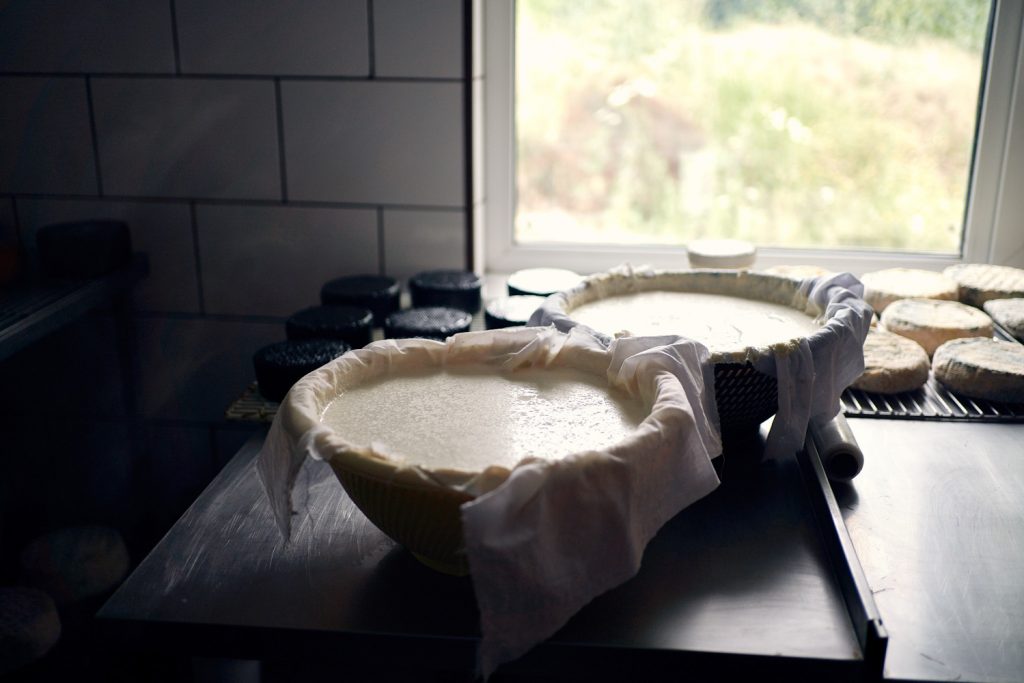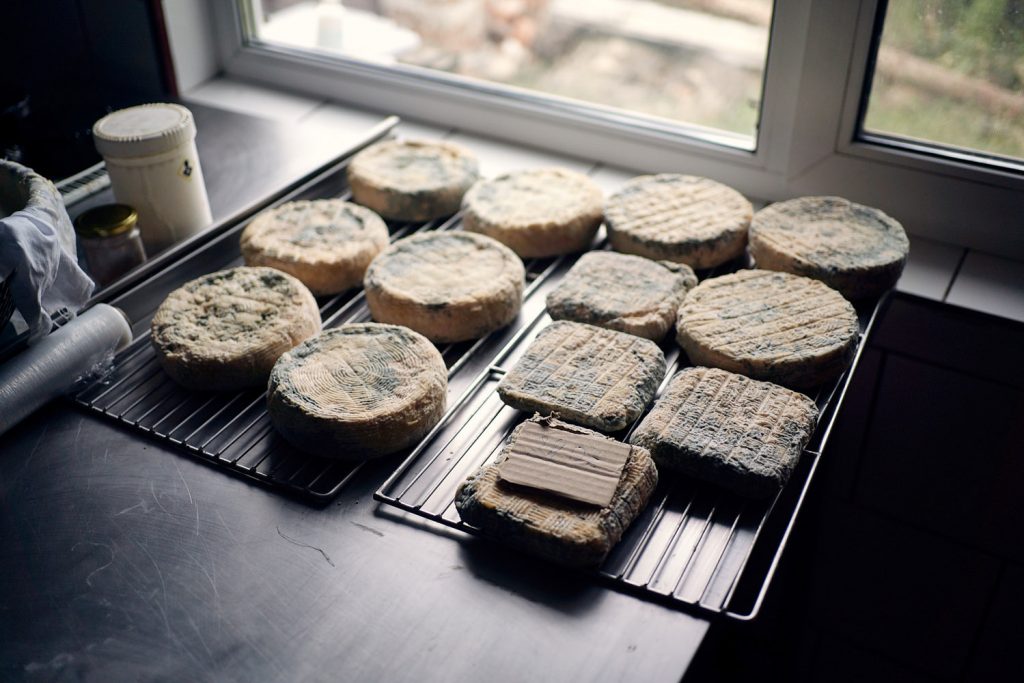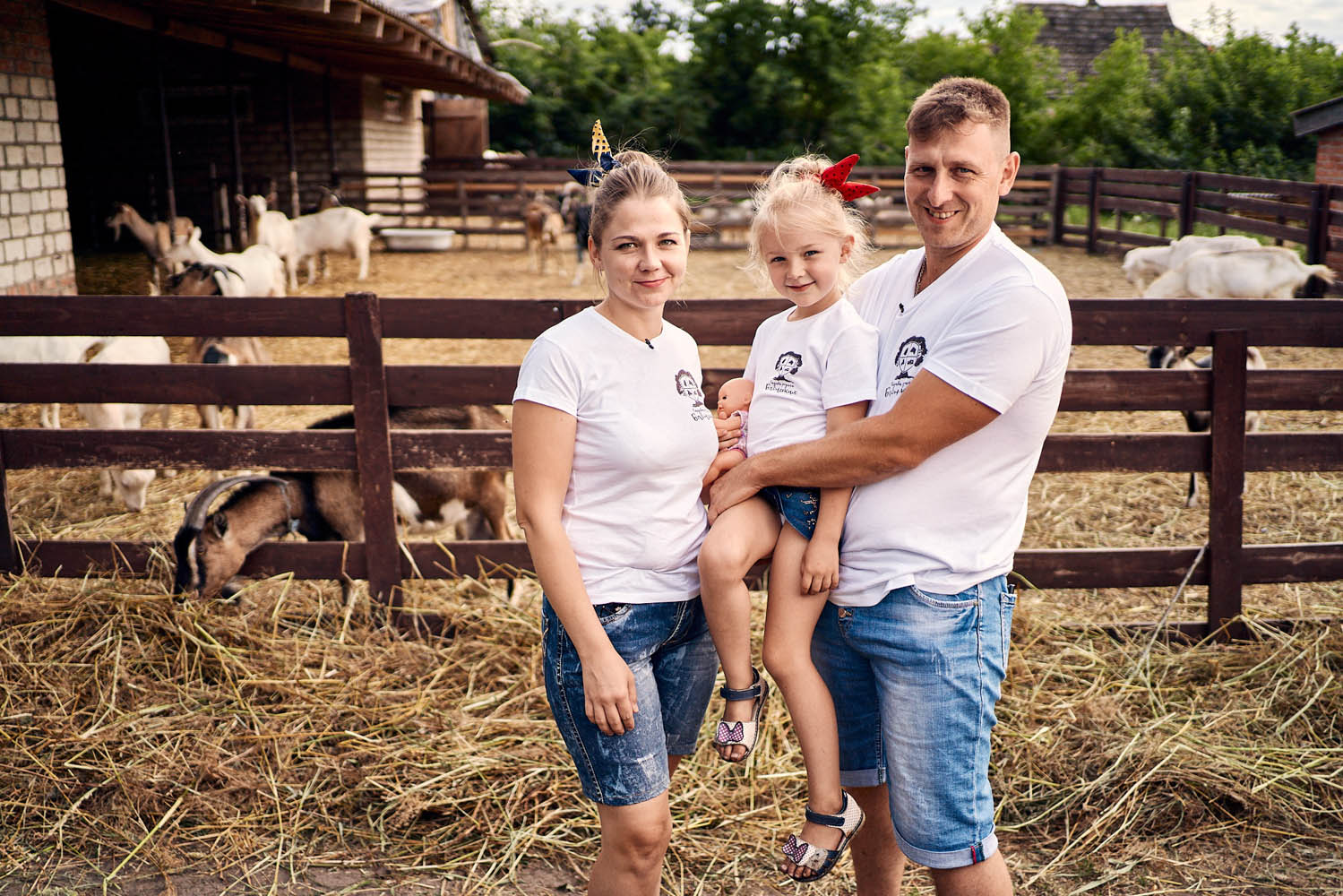Oleksandr and Maryna Blonsky come from the east of Ukraine. At the beginning of the Russo-Ukrainian war, they left their hometown of Luhansk and settled in the village of Vovnianka in Poltava Oblast, where they started their own business from scratch. They founded a goat farm and a farm-to-table cheese factory, which produces soft and aged cheeses according to their own recipes.
"The first cheese we made back in Luhansk. We had our own cheese dairy at the restaurant. And the first attempts were made right there. A Georgian friend of ours who was a chef passed on the basic methods of making brynza and suluguni (Moldovian and Georgian types of brined cheese, - Ed.). And further on we developed them ourselves by trial and error," says Oleksandr.After he left the restaurant, Oleksandr worked as a crisis manager. He rescued failing projects and revived them. Maryna used her experience to help start-ups.
"We had been involved in freelance work for the last three years (in Luhansk — ed.). And then we decided to become cheesemakers and farmers," the spouses say.

After the birth of their daughter Zlata, the couple decided that they needed to start their own business. Initially, they bought milk for the last 330 hryvnias of the family budget. They were cooking the cheese in a pan on the hearth or on a wood stove in the wintertime. Oleksandr was selling cheese at the market, but in the frontline village, it was not in great demand.Until the last moment, I was saying, 'I won’t leave my apartment for anywhere!' But, when there are 24 Grad shells (multiple rocket launcher BM-21 Grad, - Ed) flying overhead, you start thinking about your own life. After all, with your own head and hands, you can earn money anywhere. And the examples of Ossetia and Transnistria proved us that we had to leave," says Oleksandr, reminding that the economy has been in stagnation in the Russian-occupied territories of Moldova and Georgia for twenty-plus years.
A new home in the central Ukrainian countryside
The family started to consider moving to their own home. They were choosing between western and central Ukraine. The only thing that was indisputable was that it should be a house in a village.The opportunity to start searching closely for a house to buy arose when the family arrived in Poltava Oblast to visit Oleksandr’s relations. They came to show the great-granddaughter to the elderly, and, in the end, the family made about 600 kilometers in three days, driving across the area in their house hunting. They settled on house no. 29, this one was in the village of Vovnianka."The city means the format of hired labor. I was no longer interested in going to work for someone within my specialty. And buying an apartment in the city was unrealistic. I lived in the city for 30 years and I wanted to move now to the countryside, get engaged in cheese production, farming, and animal husbandry," Oleksandr said.

"Why Vovnianka? It just turned out that way. The house had the combination of a good price and quality. We came and saw a big house with big windows and high ceilings. A large, spacious garden. All the houses we had viewed before had wooden outbuildings nearly on top of each other. A henhouse, a smaller hen house, a duck house, and there's something for a dog. And here we saw a big, unlittered, spacious garden," says OleksandrThey first came to Vovnianka in early May.
"We arrived, and there was green grass around, it was cozy and clean. We came out of the house, and Maryna said: 'I want this house!'," Oleksandr recalls.

- Read also: Michel and his Carpathian buffaloes
Goats: exotic and easier to feed
In Vovnianka their production began with a 300-liter cheese vat and two refrigerators. The Blonskys took advantage of the resettlement programs for the internally displaced to start their own business. With the funds acquired, they purchased stainless steel equipment and furniture for the production facility. They also began large-scale construction of a two-story cellar for cheese aging.
"I was said, 'A village! What have you come up with? Who's gonna come to you?' And I say it’s just a spot on the map, a piece of geography. Doesn’t matter whether it’s Vovnianka or Luhansk. Because the main thing is what you do. And you have to love what you do. Then the success will come."Initially, Oleksandr was buying milk for cheese around Vovnianka, from 40 village goat-keepers. But the lack of milk quality control forced him to get his own herd. Today the farm has more than 50 animals, including 22 dairy goats. Maryna looks for clients, processes orders, packs and sends products. She also monitors the new small business support grants. Oleksandr takes care of animal feeding and produces the cheese.

"We chose goat's milk because you won't amaze or interest anyone with dairy products from cow nowadays, and goat’s milk was a novelty, it was interesting and useful."

- Read also: Oleksandr the Good Shepherd
240 kilos of cheese a month
"We are still buying more milk because our own isn't enough. We get it from reliable households and regularly test the milk in a mini-laboratory. We plan to breed 50 dairy goats and to work only with our milk."The Blonskys have their own ‘Ecomilk’ mini-laboratory where milk can be tested for the content of fat, water content, proteins, and pH level. Additionally, they use chemicals to check it for mastitis. Oleksandr calls the cheese vat, originally brought from Lubny, “our breadwinner”. The cheese is cooked in it on firewood, according to an old technique. The total volume of the vat is 300 liters. The maximum amount of milk processed by the cheesemakers per day is 900 liters. They heat up the milk to prepare the cheese. Then they introduce a natural enzyme for milk coagulation into the cheese curd, which is then cut, and the resulting cheese curd is put into molds. The time it is kept in the molds depends on the type of cheese you want to get. Some cheese is pressed. Then the finished young raw material is sprinkled with salt or poured with brine.

"Let’s say, at 6 a.m. I drive to collect milk, come back, and our milk arrives. I start cooking at 9, and I don’t leave the cheese until 6 o’clock in the evening. There is a lot of manual work in cheese production. And this is not due to a lack of money for ‘smart’ modern equipment. We do not want to turn our business into a factory that churns out identical products."The average production volume is 200-300 liters of milk every three days. That’s more than 240 kilograms of cheese a month. In order for it to mature and to be stored properly, the Blonskys constructed a two-storey temperature-controlled cheese cellar, where cheeses get aged. Different cheeses require different conditions for proper maturation. Those with mold and without rind require warmth and moisture for the germination of penicillin in the first stage. For hard and extra-hard cheese with a rind, on the contrary, cold and moderate humidity are suitable. The rind of hard cheeses gets washed after drying and they go to the cellar for maturation. The six-meter cheese cellar is filled with hard and extra-hard cheeses after salting and drying the cheese rind. The Blonskys cover them with a paraffin film, which protects the block of cheese from mold, formed on the outside.
"We age it for three to six months. We experimented with aging it for a year, but for this, you should make a big block of at least 8 kilograms. We mostly make extra-hard cheese in one-kilogram blocks."The Blonskys’ depository gives customers the opportunity to buy young cheese and leave it to mature in the cellar for at least six months. Buyers get the cheese in the finished extra hard form. Thus, it is possible to save money, because the final extra-hard cheese is more expensive. All their cheeses are artisanal, with their own name and history. They produce six basic types and sometimes try things out. Among their products there a variety of hard cheeses.

3,000 regular customers
Oleksandr and Maryna say they look at cheese from the consumer’s perspective. Therefore, the cheese “Fresh” similar to feta is canned in pieces with olive oil in jars, with olives. They say it’s almost a ready-to-use base for Greek salad, you just need to add vegetables. Cream cheese that is similar to ricotta is salted, herbs are added, and so it is convenient to spread on sandwiches, add to pasta, etc."We freeze ricotta because it can be stored in the refrigerator for no more than two days. This is the only cheese that hardly changes after freezing. In addition, since we mostly send orders by Nova Poshta delivery service, it acts as a refrigerant when frozen. It arrives with the customer already defrosted. On the package, we indicate the expiry date and under what temperature conditions it should be stored," says Maryna.There is a separate refrigerator for moldy cheeses of different ages.
"This year for the first time we experimented with Greek yogurt. The city of Myrhorod has already been treated to it. Goat’s milk and goat’s yogurt are generally 'mind-blowing' for people. People are just used to goat’s cheese, and here we have goat’s yogurt for you."

- Read also: First oyster farm in mainland Ukraine plans to ramp up production (2017)
"We mostly sell cheese in sets. This is a set of six types of cheese. We also put in the homemade white mulberry jam. It goes like an amuse-bouche (kind of an appetizer, - Ed.). There are cheeses of various kinds. From young and creamy to hard and aged, and moldy. The jam acts as a refrigerant, in order for the set to be transported well."

Creating Europe around yourself
Oleksandr and Maryna both say their biggest problem is the lack of a labor force. The village is small, and the choice of workers is very limited. They need people for the development of green tourism, but they don't have the opportunity to engage their relatives and set up a full-fledged family business. Now, the Blonskys only employ three local women who help them with the goats."We like farming because there is always work to do. 24/7, all year round. In general, we do not feel sorry for ourselves. We do not expect somebody to help us. We only hope that people will work with us while government authorities won't interfere. There are many cheese dairies now, but each consumer chooses what he likes. Competition is only in the heads, it is a psychological moment," says Oleksandr.For Oleksandr and Maryna, farming is an opportunity for self-realization. That's why in the near future, in order to develop the business's green tourism part, they plan to build a restaurant and a holiday cottage for excursions and tastings. They don't consider the possibility of returning to Luhansk (which remains under the Russian occupation for seven years now, - Ed).

"The most painful thing is that I left friends there. A reliable team that always supports you and sticks around. Many of them left too. Some of them stayed, some went abroad. We're trying to be in touch with those with whom we contacted closely"The Blonskys say that often their friends can't wrap their heads around their choice.
"Many people tell us that we have to go to Europe. And I say, we have to create Europe around us. Our people are still throwing garbage on roadsides, and at the same time, they want to take steps to reach Europe somehow. But we are not needed in Europe with such habits. Ukraine should be here (touches his heart) first and foremost. And everything else is changeable," says Oleksandr
Read also:
- Wild-honey farmers of Polissya: People of the forest
- “Land of opportunities”: How a Swiss woman fulfilled her dream of an organic tea business in Ukraine
- How two friends united by war turned Ukrainian shrimp from myth to reality
- First oyster farm in mainland Ukraine plans to ramp up production (2017)
- Grandfather’s hut turned into Hutsul art residence in heart of Carpathians
- Oleksandr the Good Shepherd
- Michel and his Carpathian buffaloes
- Ukrainian Donbas war veteran creates innovative poultry farm as part of SME-boosting program
- The village creating Ukraine’s eco-friendly iconic brooms
- Ukrainian startup starts selling paper made from fallen leaves
- How an American expat pulled the Ukrainian art of Kobzaring back from the brink of extinction
- How Eastern Ukraine IDPs succeed in business after escaping the war
- Historical reconstruction breathes new life into Ukraine’s iconic Kamianets-Podilskyi fortress
- Meet Ukraїner, “project that tells the world about the least discovered country in Europe”

